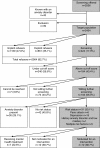Prevention of anxiety disorders in primary care: a feasibility study
- PMID: 23173774
- PMCID: PMC3528409
- DOI: 10.1186/1471-244X-12-206
Prevention of anxiety disorders in primary care: a feasibility study
Abstract
Background: Anxiety disorders are highly prevalent in primary care and cause a substantial burden of disease. Screening on risk status, followed by preventive interventions in those at risk may prevent the onset of anxiety disorders, and thereby reduce the disease burden. The willingness to participate in screening and interventions is crucial for the scope of preventive strategies, but unknown. This feasibility study, therefore, investigated participation rates of screening and preventive services for anxiety disorders in primary care, and explored reasons to refrain from screening.
Methods: In three general practices, screening was offered to individuals visiting their general practitioner (total n = 2454). To assess risk status, a 10-item questionnaire was followed by a telephone interview (including the CIDI) when scoring above a predefined threshold. Preventive services were offered to those at risk. Participation rates for screening and preventive services for anxiety disorders were assessed. Those not willing to be screened were asked for their main reason to refrain from screening.
Results: Of all individuals, 17.3% participated in initial screening, and of those with a possible risk status, 56.0% continued screening. In 30.1% of those assessed, a risk status to develop an anxiety disorder was verified. Of these, 22.6% already received some form of mental health treatment and 38.7% of them agreed to participate in a preventive intervention and were referred. The most frequently mentioned reasons to refrain from screening were the emotional burden associated with elevated risk status, the assumption not to be at risk, and a lack of motivation to act upon an elevated risk status by using preventive services.
Conclusions: Screening in general practice, followed by offering services to prevent anxiety disorders in those at risk did not appear to be a feasible strategy due to low participation rates. To enable the development of feasible and cost-effective preventive strategies, exploring the reasons of low participation rates, considering involving general practitioners in preventive strategies, and looking at preventive strategies in somatic health care with proven feasibility may be helpful.
Similar articles
-
Validation of the Computerized Adaptive Test for Mental Health in Primary Care.Ann Fam Med. 2019 Jan;17(1):23-30. doi: 10.1370/afm.2316. Ann Fam Med. 2019. PMID: 30670391 Free PMC article.
-
Anxiety disorders in primary care: prevalence, impairment, comorbidity, and detection.Ann Intern Med. 2007 Mar 6;146(5):317-25. doi: 10.7326/0003-4819-146-5-200703060-00004. Ann Intern Med. 2007. PMID: 17339617
-
[Prevalence of depressive disorders in children and adolescents attending primary care. A survey with the Aquitaine Sentinelle Network].Encephale. 2003 Sep-Oct;29(5):391-400. Encephale. 2003. PMID: 14615688 French.
-
Screening and brief intervention for alcohol and other abuse.Adolesc Med State Art Rev. 2014 Apr;25(1):126-56. Adolesc Med State Art Rev. 2014. PMID: 25022191 Review.
-
Detection and diagnosis of psychiatric disorders in primary medical care settings.Med Clin North Am. 2001 May;85(3):579-96. doi: 10.1016/s0025-7125(05)70330-8. Med Clin North Am. 2001. PMID: 11349474 Review.
Cited by
-
Screening high-risk patients and assisting in diagnosing anxiety in primary care: the Patient Health Questionnaire evaluated.BMC Psychiatry. 2013 Jul 17;13:192. doi: 10.1186/1471-244X-13-192. BMC Psychiatry. 2013. PMID: 23865984 Free PMC article.
-
An internet-based adolescent depression preventive intervention: study protocol for a randomized control trial.Trials. 2015 May 1;16:203. doi: 10.1186/s13063-015-0705-2. Trials. 2015. PMID: 25927539 Free PMC article. Clinical Trial.
References
-
- Wilson JMG, Jungner G. Principles and practice of screening for disease. Geneva: World Health Organization; 1968.
-
- Alonso J, Angermeyer MC, Bernert S, Bruffaerts R, Brugha TS, Bryson H, de Girolamo G, de Graaf R, Demyttenaere K, Gasquet I, Haro JM, Katz SJ, Kessler RC, Kovess V, Lepine JP, Ormel J, Polidori G, Russo LJ, Vilagut G, Almansa J, Rbabzadeh-Bouchez S, Autonell J, Bernal M, Buist-Bouwman MA, Codony M, Domingo-Salvany A, Ferrer M, Joo SS, Martinez-Alonso M, Matschinger H. et al.Prevalence of mental disorders in Europe: results from the European Study of the Epidemiology of Mental Disorders (ESEMeD) project. Acta Psychiatr Scand. 2004;420(Suppl):21–27. - PubMed
-
- Bijl RV, de Graaf R, Ravelli A, Smit F, Vollebergh WA. Gender and age-specific first incidence of DSM-III-R psychiatric disorders in the general population. Results from the Netherlands Mental Health Survey and Incidence Study (NEMESIS) Soc Psychiatry Psychiatr Epidemiol. 2002;37:372–379. doi: 10.1007/s00127-002-0566-3. - DOI - PubMed
Publication types
MeSH terms
LinkOut - more resources
Full Text Sources
Medical


